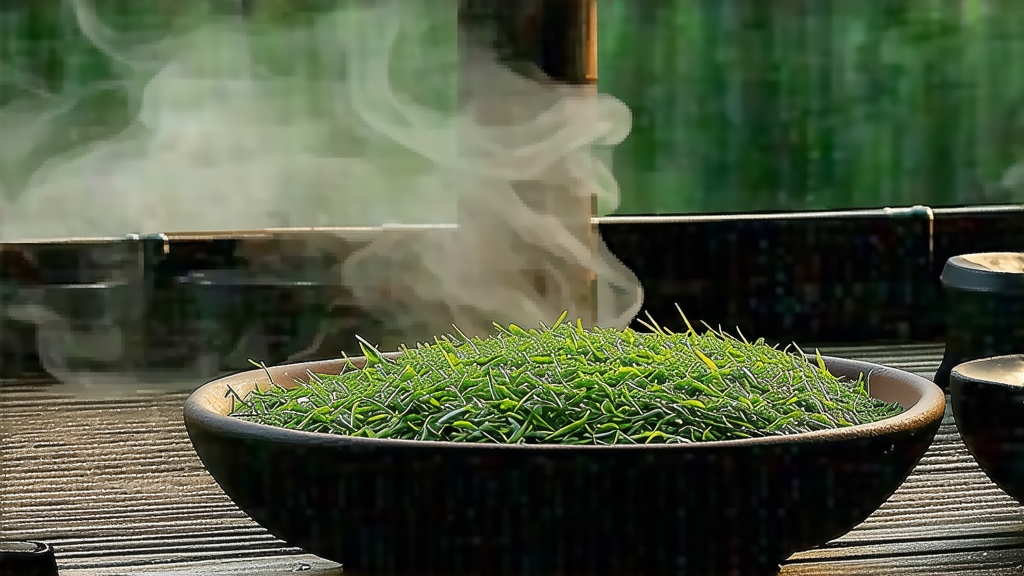
Tucked away in the humid, karst-pitted mountains of southern Guangxi, Liu Bao cha has spent four centuries quietly fermenting its way into the hearts of truck drivers, dock workers, and, more recently, global tea connoisseurs. To the uninitiated it is merely another dark brick, but to those who have tasted its cocoa-betel depth it is a liquid archive of south China’s river trade, minority craftsmanship, and the invisible artistry of microbes.
Historical currents
The story begins in the small township of Liu Bao, Wuzhou prefecture, where the Wu River once merged with the Xi Jiang artery to Guangzhou. During the Qing dynasty, pressed tea was an ideal currency for paying porters and boatmen; compressed leaves resisted mold, occupied little space, and improved rather than spoiled on long, steamy journeys. By the late 1600s Liu Bao was already listed among the “24 famous teas” in the imperial annals, yet its fame remained regional, eclipsed by the pu-erh caravans heading west to Tibet. Everything changed in 1950 when the state-designated China Tea Company Guangxi Branch standardized the name and built the first dedicated factory. Exports to Hong Kong, Malaysia, and Singapore soared; dockworkers swore the tea cut through grease and cured “dim sum fatigue,” while tin-mine coolies believed it expelled dampness and guarded against malaria. Thus Liu Bao crossed oceans, embedding itself in Southeast Asian coffee-shop culture decades before the West discovered “dark tea.”
Varietal identity within the heicha family
Chinese taxonomy places Liu Bao under the broader heicha (literally “black/dark tea”) umbrella, yet it is neither pu-erh nor Hunan fu-zhuan. Its leaf is almost exclusively the Guangxi native Da Ye cultivar—large, thick, and resinous, bred by subtropical heat into a chemical profile rich in polyphenols and pectin. Locals grade it by leaf maturity: gong fu (budset), te ji (special grade), yi ji (1st), san ji (3rd), down to cu cha (broken). Age statements follow a twenty-character cyclical calendar etched on the bamboo casing, but connoisseurs speak in eras—pre-1990 “wet warehouse” bricks prized for camphor notes, 2000–2005 “dry warehouse” cakes that foreground jujube sweetness, and the post-2010 boutique “single mountain” micro-batches that echo the terroir-driven revolution already seen in Yunnan.
Craft: from solar withering to the “golden flower” gamble
Plucking occurs from April to October when humidity hovers at 80 %. Leaves are solar-withered for three to five hours until the edges curl like parchment, then wok-fired at 180 °C for eight minutes—just enough to denature enzymes while preserving leaf integrity. The crucial divergence from green-tea fixation is the retention of 12–15 % moisture, an invitation for later microbial drama.
Next comes rolling, first mechanically then by foot on a 2 m bamboo tray, a rhythmic dance that ruptures cells without shredding veins. Piles weighing 60 kg are heaped inside steamed wooden crates; the “wet piling” (wo dui) phase lasts 10–14 days, shorter than ripe pu-erh because Guangxi’s ambient heat accelerates fermentation. Thermometers are plunged into the core every four hours; when the pile hits 55 °C it is turned, sprayed with river water, and re-stacked. The goal is to cultivate Aspergillus niger, Blastobotrys adeninivorans, and a rare yeast Candida lunata, microbes that convert catechins into theaflavins, gallic acid, and that signature earthy aroma reminiscent of petrichor after a monsoon.
After piling, leaves are steamed again and pressed into 40 kg bamboo baskets lined with wild taro leaves. Seven workers stand atop a wooden plank, stamping in unison until the basket resembles a dense hockey puck. A final twist of rattan seals the top, and the basket is moved to an above-ground “drying room” where 28 °C air circulates for two weeks. Some producers then transfer the baskets to natural caves—constant 22 °C, 85 % humidity—mimicking the conditions of the original river-boat holds. Here the tea may sleep for three, ten, even thirty years, growing a gentle dusting of golden eurotium cristatum